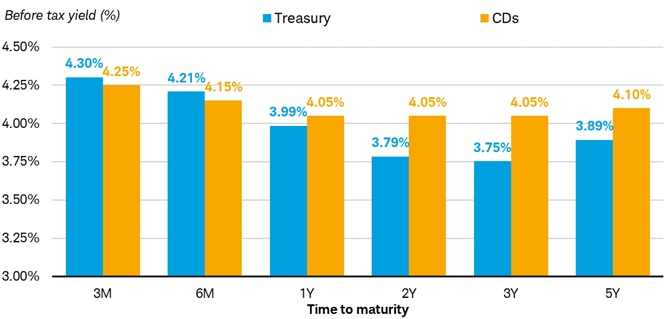CD or Treasury? Five Factors to Consider

Two of the historically safest types of fixed income investments are certificates of deposit (CDs) and Treasury bonds. Both CDs and Treasuries can be a good choice when you want steady, predictable investment income—but how should an investor decide between them?
Before choosing CDs or Treasuries, we suggest you first start with your objectives. Not considering your objectives before investing is like taking a road trip and only being concerned about the tires on the car—not where you're going. The benefits of both CDs and Treasuries are that they can generate income, protect your principal, and help diversify your portfolio. Additionally, Treasuries can have tax benefits when compared to CDs. However, CDs and Treasuries are fixed income investments and subject to similar risks as other fixed income investments. For example, if interest rates rise, the price of a CD or Treasury will fall and if you need the investment prior to maturity and have to sell it, you may lose money.
When considering between the two investment options, there are five factors that investors should consider.
Treasuries relative to CD yields

Source: Bloomberg for Treasury yields and Schwab BondSource ™ for CD yields, as of 5/6/2025.
Examples provided are for illustrative purposes only and not intended to be reflective of results you can expect to achieve. CDs were chosen because they were the highest yielding, new issue CD for each maturity, based on a $25,000 purchase amount. New issue CDs have a selling concession that varies. Secondary CDs may have a transaction fee. CDs may not be available in all states and the availability of CD inventory may change. Treasury securities were chosen because they are on the run Treasuries; "on the run" means the most recently issued U.S. Treasury bonds or notes of a particular maturity. USGG3M Govt for 3-month Treasury, USGG6M Govt for 6-month Treasury, USGG12M for 12-month Treasury, GT2 Govt for 2-year Treasury, GT3 Govt for 3-year Treasury, and GT5 Govt for 5-year Treasury. Past performance is no guarantee of future results.
Treasuries can offer tax benefits that CDs do not. Income from Treasuries are exempt from state income taxes, whereas CDs are subject to both federal and state income taxes. As a result, investors who are choosing between the two options should start with what account type they are investing in, and then consider what their state tax rate is. If investing in a tax-sheltered account, like an individual retirement account (IRA) or a 401(k), the tax benefits that Treasuries provide disappear, because earnings in these types of accounts are not subject to income taxes.
However, if investing in a taxable account, like a brokerage account, the impact of state income taxes can tip the scales one way or the other. For investors in high-tax states, like New York or California, after considering the impact of state taxes, investors may be able to achieve a higher after-tax yield with Treasuries.
For example, assume a three-year CD currently yields 4.05%, compared to a three-year Treasury that yields 3.75%1. For an investor in the top tax bracket in California, which has a 13.3% state tax rate, after the impact of state taxes, the CD yields 3.51%. In this instance, the investor can achieve a higher after-tax yield with the Treasury versus the CD.
For investors in other states, it takes a roughly 6.5% state tax rate for a CD that matures beyond two years to equal the yield on a Treasury of similar maturity. However, this "breakeven" tax rate will fluctuate over time depending on interest rates, the availability of CDs, and other factors.
Investors in high-tax states may want to consider Treasuries over CDs due to their tax benefits

Tax Foundation, as of 1/1/2024.
Treasuries have maturities ranging from as little as four weeks to as long as 30 years. On the other hand, the availability of CDs beyond five years is limited in many instances. For investors that desire a greater selection of maturities, Treasuries can make more sense.
What to consider
One strategy to consider when investing in CDs or Treasuries is a ladder. A ladder is a portfolio of individual Treasuries or CDs that mature on different dates. This can help minimize exposure to interest rate fluctuations. Additionally, investors may want to consider a separately managed account (SMA) that can help build and manage a ladder. For help selecting investments for your particular situation, reach out to a Schwab representative.
Thomas Byrne, Senior Fixed Income Specialist, contributed to this report.
1 Schwab BondSource and Bloomberg as of 5/6/2025.
2 Based on the highest yielding new issue CD available on Schwab BondSource™ as of 5/6/25 for 3-month, 6-month, and 12-month maturities compared to USGG3M Govt for 3-month Treasuries, USGG6M Govt for 6-month Treasuries, USGG12M for 12-month Treasuries.
3 New-issue CDs have a selling concession which can vary by maturity/term. Secondary CDs may have a transaction fee.